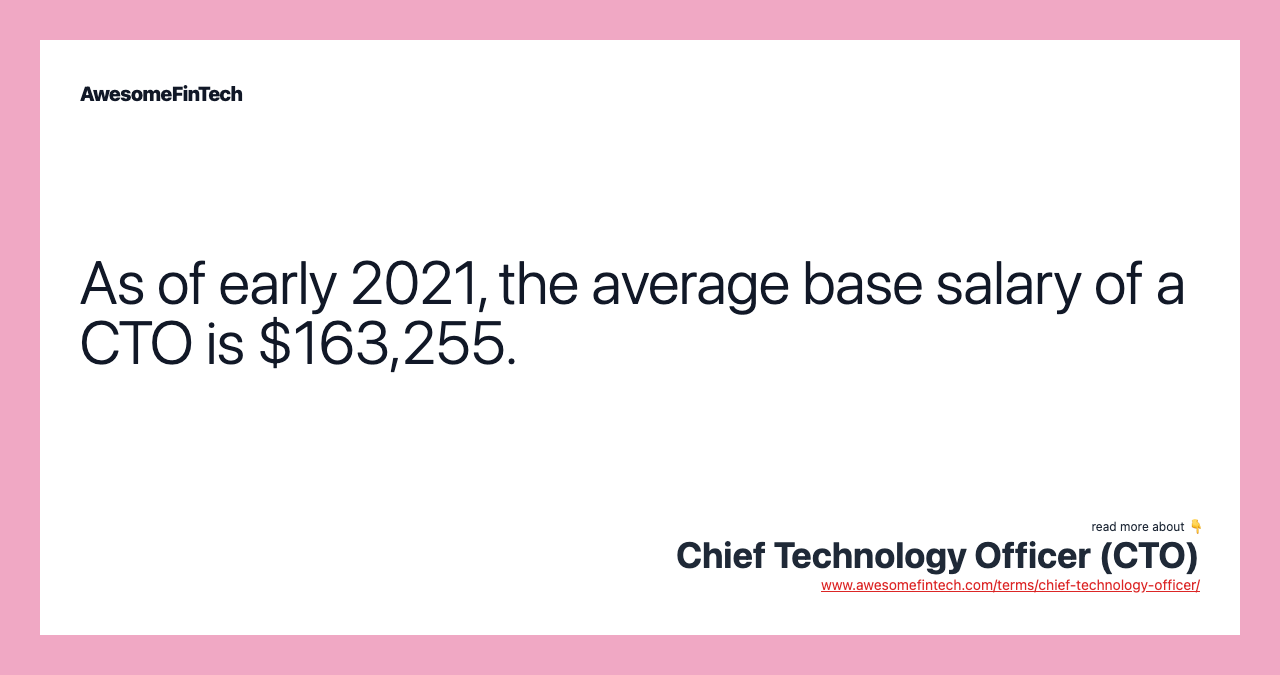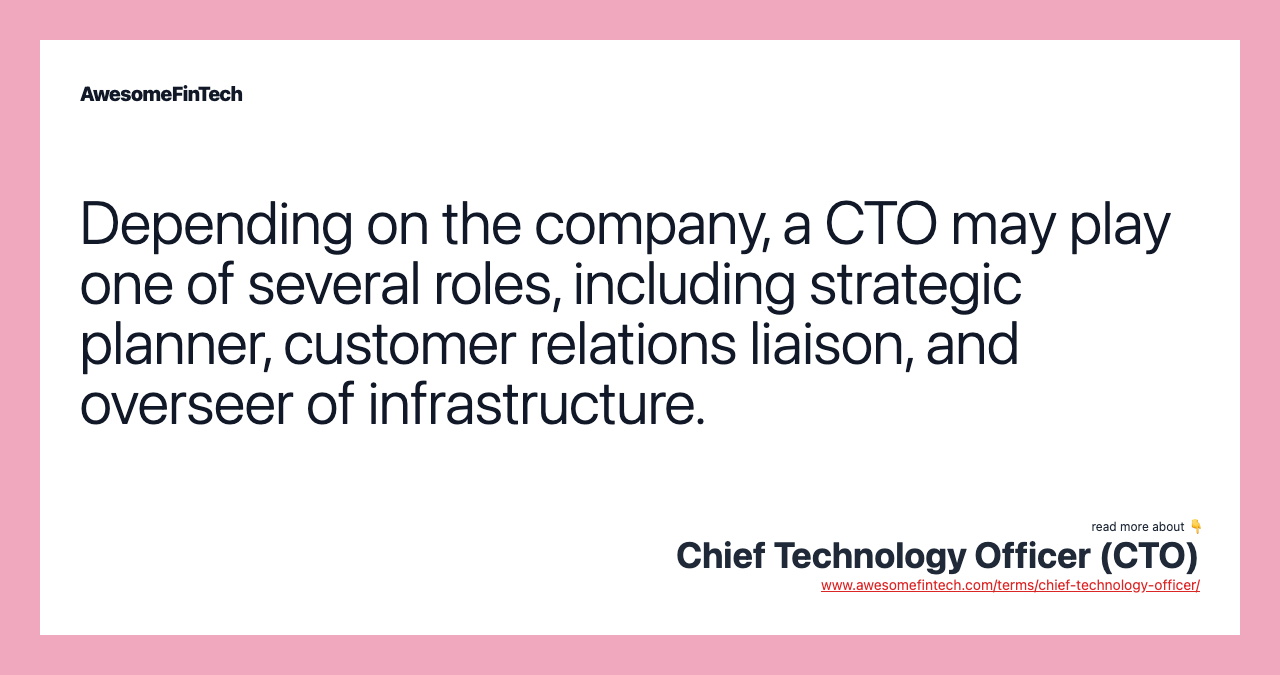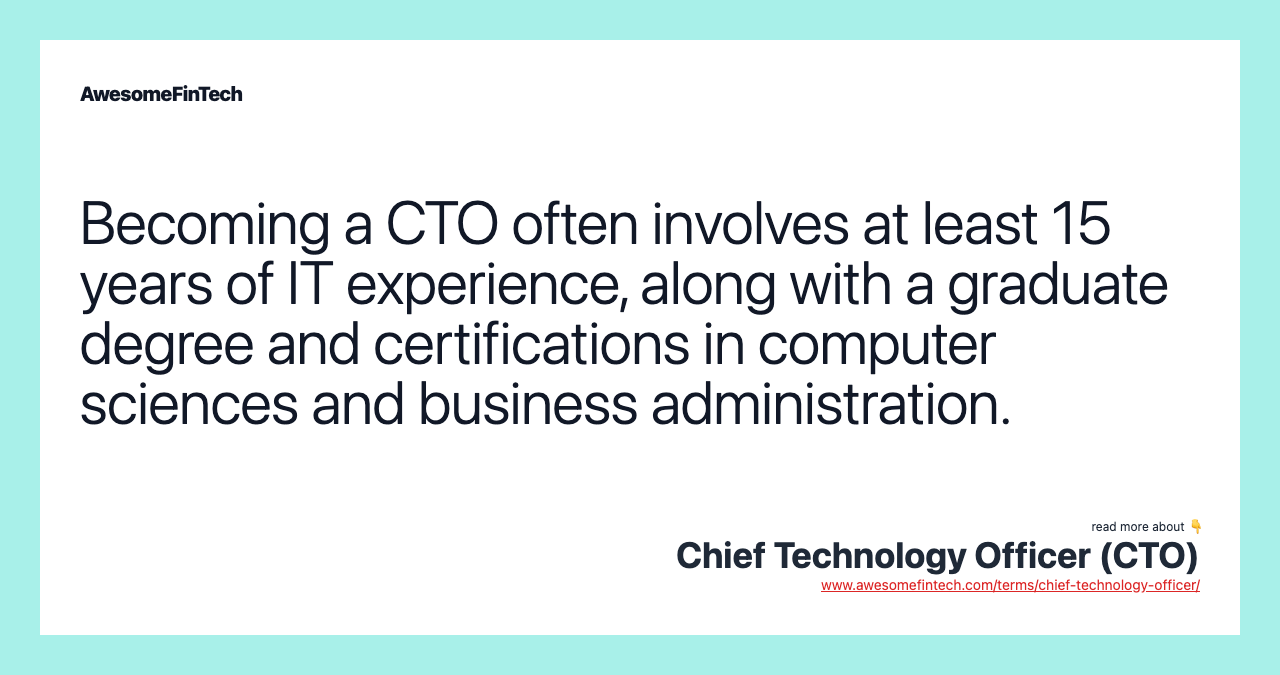Chief Technology Officer (CTO)
Table of Contents What Is a Chief Technology Officer? A chief technology officer (CTO) is the highest technology executive position within a company and leads the technology or engineering department. A chief technology officer (CTO) is responsible for overseeing the development and dissemination of technology for external customers, vendors, and other clients to help improve and increase business. Originally a chief information officer (CIO) previously performed dual roles as CIO and chief technology officer (CTO). The CTO usually reports directly to a company's chief information officer (CIO), but may also report to the chief executive officer (CEO) of the firm.

What Is a Chief Technology Officer (CTO)?
A chief technology officer (CTO) is the executive in charge of an organization's technological needs as well as its research and development (R&D). Also known as a chief technical officer, this individual examines the short- and long-term needs of an organization and utilizes capital to make investments designed to help the organization reach its objectives. The CTO usually reports directly to a company's chief information officer (CIO), but may also report to the chief executive officer (CEO) of the firm.




Understanding the Role of the Chief Technology Officer (CTO)
A chief technology officer (CTO) is the highest technology executive position within a company and leads the technology or engineering department. They develop policies and procedures and use technology to enhance products and services that focus on external customers. The CTO also develops strategies to increase revenue and performs a cost-benefit analysis and return-on-investment analysis.
Originally a chief information officer (CIO) previously performed dual roles as CIO and chief technology officer (CTO). However, as technology continued to advance, there was a growing need to separate the CIO job into two roles to ensure a company's success. Hence, the development of the CTO as a separate position.
How do the two differ? Despite the titles, the CTO has more of an outward-looking, strategic planning role, while the CIO has more of a technology-focused, operational role. Generally, a CIO is responsible for technologies that run the company's internal operations and business procedures. The CTO is responsible for technologies that grow the business externally, implementing services and products that serve clients and customers.
Many large corporations need both a CTO and CIO, while smaller companies tend to have one or the other. The choice depends on the company's vision and budget.
As technology focuses more on integrating applications, processes, and the Internet of Things, CTOs must keep abreast of big data, streaming analytics, and cloud technology to remain innovative and stay competitive.
Types of Chief Technology Officers
While research and development have been a component of businesses for many years, the rise of information technology (IT) and computers has increased the importance of the chief technology officer. Companies focusing on scientific and electronic products employ CTOs who are responsible for the oversight of intellectual property and have backgrounds in the industry.
But the responsibilities and role of the CTO also depend on the company. There are typically four different kinds of CTOs, whose main duties may differ.
Infrastructure Overseer
This CTO may oversee the company's data, security, maintenance, and the network of a company and may implement (but not necessarily set) the company's technical strategy. The CTO may also manage the company's technological roadmap.
Strategic Planner
This type of CTO may envision how technology will be used within the company while setting the technical strategy for the company. This CTO will also look at how to further implement new technologies within the company to ensure its success.
Consumer Liaison
In this role, a CTO will act as a liaison between the customer and the business by taking on the responsibilities of customer relations, getting a grasp on the target market, and helping deliver IT projects to market.
Thinker
This kind of CTO will help set up the corporate strategy and fuel technological infrastructure, will analyze target markets, and create business models. Additionally, the CTO will have a close relationship with the CEO and other members of the company's senior management.
Becoming a Chief Technology Officer (CTO)
As with most jobs in the IT industry, the path to CTO starts with a bachelor’s degree in a computer- or information science-related field (computer programming, software development, management information systems, applied mathematics, cybersecurity).
Many firms also prefer their CTOs to have M.A.s: master's degrees in computer sciences, information technologies, or technology management. Given the fact that CTOs often focus on products for customers and customer relations, sales, and marketing courses are often useful as well. Many chief technology officers have MBA degrees, reflecting the significance of IT in strategic corporate planning and business goals.
On-the-job, practical experience is important: Most CTOs have worked their way up the IT ranks at different organizations. Industry certifications, if not crucial, can significantly enhance an applicant's credentials as well.
A chief technology officer is a high-ranking executive-level position in a company, part of the senior-level, "c-suite." So applicants may need more than 15 years of experience in the IT field before being considered for a CTO job.
In 2021, annual salaries for CTOs range from $89,000 to $246,000, according to Payscale.
$163,255
The average base salary of a CTO in 2021, according to PayScale.
Special Considerations
The U.S. Bureau of Labor Statistics predicts that the job outlook for CTOs, along with other computer and information systems managers, is good: Employment is expected to increase 10% between 2019 and 2029 — much faster than the average 4% for all jobs.
The continued growth of business conducted over information systems is the main cause of employment growth in this role. Rapid advancements in business solutions and growth in mobile device usage and cloud computing usage have also contributed to the expected increase in job openings.
In 2009, the White House announced the appointment of the country's very first CTO, an official in the Office of Science and Technology Policy. This official's main focus is to use technology to help stimulate job creation, improve healthcare and security systems, and increase broadband access. Aneesh Chopra was the first CTO of the U.S.
Chief Technology Officer FAQs
What Does a CTO Do?
Chief technology officers (CTOs) evaluate new technology and implement it to launch or improve goods and services for their firm's clientele and customers.
Are CTO and CIO the Same?
Although there is overlap between the two positions, since both deal with IT, CTOs generally look outward, using technology to improve the company's customer experience — the use of the goods and services. CIOs generally look inward, developing and using technology to improve the company's procedures and operations.
Who Does a CTO Report To?
CTOs often report to CIOs. However, they may report directly to a company's CEO, especially if there is no CIO position.
What Does a Chief Technology Officer Do?
A chief technology officer (CTO) is responsible for overseeing the development and dissemination of technology for external customers, vendors, and other clients to help improve and increase business. They may also deal with internal IT operations if a company is small and doesn't have a chief information officer.
What It Takes To Become a CTO
CTOs start out with bachelor's degrees in a computer-science-related field. They often earn master's degrees as well, again in computer sciences or mathematics fields — though more general MBAs are common as well.
CTOs generally have at least 15 years of IT job experience under their belts. Along with technical expertise, they must demonstrate leadership, decision-making, management, and business strategy skills.
Related terms:
C-Suite
C-Suite is a widely-used informal term used to refer collectively to a corporation's most important senior executives—as in CEO, CFO, and COO. read more
Chief Executive Officer (CEO)
A chief executive officer (CEO) is the highest-ranking executive of a firm. CEOs act as the company's public face and make major corporate decisions. read more
Chief Financial Officer (CFO)
A chief financial officer (CFO) is the senior manager responsible for overseeing the financial activities of an entire company. read more
Chief Information Officer (CIO)
A chief information officer (CIO) is the company executive responsible for the management and implementation of information and computer technologies. read more
Cloud Computing
Cloud computing is a model for delivering information technology services where resources are retrieved from the internet through web-based tools. read more
Chief Operating Officer (COO)
The chief operating officer (COO) is a senior executive tasked with overseeing the day-to-day administrative and operational functions of a business. read more
Cost-Benefit Analysis (CBA)
A cost-benefit analysis (CBA) is a process used to measure the benefits of a decision or taking action minus the costs associated with taking that action. read more
Dotcom
A dotcom, or dot-com, is a company that uses the Internet as a key component in its business. It most often refers to an early web pioneer. read more
The Internet of Things (IoT): An Overview
The Internet of Things (IoT) is a name for the aggregate collection of network-enabled devices, excluding traditional computers like laptops and servers. read more
Shai Agassi
Shai Agassi is an Israeli entrepreneur who founded the company Better Pace, which provided battery charging services for electric cars until it filed for bankruptcy in 2013. read more